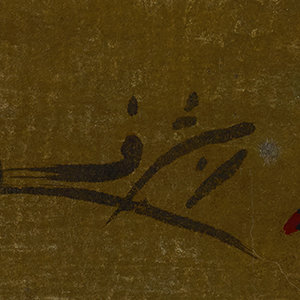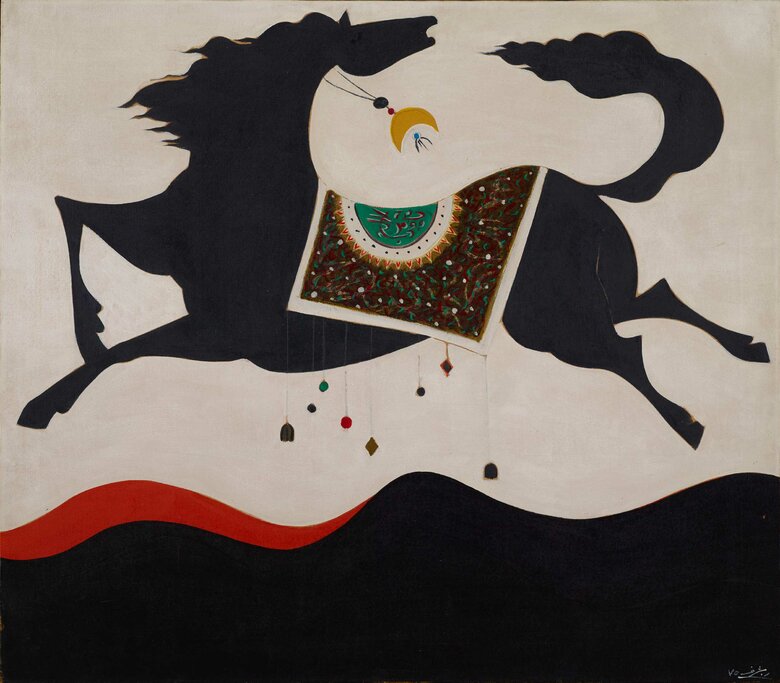Rafic Charaf was a modern Lebanese artist born in Baalbek in 1932. He is remembered for his poetic, charming abstractions of reality, creating whimsical work inspired by sociopolitical and...


RAFIC CHARAF, Lebanon (1932 - 2003)
Bio
Written by WAFA ROZ
Rafic Charaf was a modern Lebanese artist born in Baalbek in 1932. He is remembered for his poetic, charming abstractions of reality, creating whimsical work inspired by sociopolitical and autobiographical subjects, as well as poetry and folk art. He graduated from Académie Libanaise des Beaux-Arts (ALBA) in 1955, after which he was invited by the Spanish government to study for two years at the San Fernando Royal Academy in Madrid. In 1960, he traveled to the Pietro Vannucci Academy in Perugia, courtesy of the Italian government, where he pursued further training. Charaf taught at the Faculty of Fine Arts at the Lebanese University from 1965 until 1982 and was the Dean of the Faculty from 1982 until 1987. He passed away in 2003 after a prolonged battle with lung cancer.
As a boy who dropped out of school at the age of thirteen, Charaf spent most of his time at his father's blacksmith shop. His nickname was "the black plague" because he usually had a smudged face from his work in his father's forge.
At this time, he displayed a remarkable aptitude for art: he used to carry charcoal in his pockets and draw on any surface that worked as a background for his creations. In his early stages, Charaf produced charcoal drawings expressing poverty and hardship related to his surroundings. His career took off at the age of sixteen, when Lebanese poet, Loutfi Haidar, saw the young artist's drawings hanging in a Baalbek bookshop and decided to help him pursue an arts education. Through Haidar's connections with the director of the Lebanese Academy of Fine Arts, Charaf was awarded a full scholarship and enrolled at the academy in 1952.
Among his unique works during the 1960s were oil paintings depicting natural phenomena such as birds, landscapes, and lonesome, swaying trees. In his birds' subject matter, he represented his dream of flying, illustrating lonely slender birds in angular forms, still or flying swiftly in an imaginary land. His fields portrayed the vast meadows of the Beqaa Valley, reminiscent of the endless space where he used to wonder and dream. Charaf's bleak perception of life, rooted in his difficult childhood, was reflected in his work of this period, which featured muted, melancholic colors, and landscapes crisscrossed by wires and dead trees. In many of his works from the 1960s, we see simple forms rendered with visible, expressive brushstrokes; there are also large planes of flat color, however, that foreshadow what would become the artist's signature style.
During the 1970s, Charaf turned to mythological themes, producing some of his most famous works based on the folk heritage of his native Baalbek. For the artist, fantasy provided an escape mechanism through which he could overcome his distress following the 1967 Arab defeat. He found solace in legendary love stories and their invincible heroes, which symbolized a childlike hope for salvation in the face of despair. Drawing inspiration from the work of Syrian artist Abou Subhi al Tinawi, Charaf selected characters from traditional stories and classical Arabic literature. The artist illustrated women adorned in traditional dress, bearded men with scimitars, and Arabian horses in flat, depthless compositions reminiscent of Persian miniatures. Works of this period show deliberate, balanced use of bright colors, with large swaths of black and white enlivened by bursts of green, pink, orange, blue, and yellow. His works, inspired by popular culture, were intentionally accessible to people of all levels of society, addressed to audiences with similar backgrounds to his own.
Nearing the 1980s and 1990s, Charaf responded to the suffering of the Lebanese civil war through works related to Byzantine iconography. In Eastern traditions of Christianity, icons are not only paintings that depict saints, but they also act as animate, intercessory objects. According to believers, if one directs a prayer to an icon, that prayer will reach the saint portrayed, who will hopefully act on behalf of the supplicant. Charaf's work represents colorful silhouettes of women with radiant gold light above their heads in the style of Byzantine halos; given the associations of icon paintings, this work might suggest that the road to salvation during times of war lies in the hands of the people themselves.
Rafic Charaf died of lung cancer in 2003, leaving a rich and varied oeuvre that continues to inspire artists and audiences alike.
Sources
Abillama, Nour, Marie Tomb, Tamara Zantout, and Pia Bou Khater. Art from Lebanon. Beirut, Lebanon: Wonderful Editions, 2012.
Joumaa, Jamal. “Identity and Hope, Australian Artists of Arabic Origin (A Thesis Submitted for the fulfilment of Doctor of Creative Arts – 2009. p.p 48-52. The University of Western Sydney College of Arts” http://researchdirect.uws.edu.au/islandora/object/uws%3A7002/datastream/PDF/view
LA REVUE DU LIBAN. Accessed December 04, 2017. http://www.rdl.com.lb/2003/q1/3882/arts.html
Matar, William. One Fine Art | Artists - Painters / Rafic Charaf. Accessed December 04, 2017. https://www.onefineart.com/artists/painters/Rafic-Charaf
"National Museum." Accessed December 04, 2017. http://artmodernemv.gov.lb/english/rafic-charaf
Short, Ramsay. "Rafic Charaf's art reflected his own life and his country's history." The Daily Star Newspaper - Lebanon. Accessed December 04, 2017. http://www.dailystar.com.lb/ArticlePrint.aspx?id=109370&mode=print
Youssef, Farouk. "رفيق شرف الخارج لتوه من السيرة الهلالية." العرب: أول صحيفة عربية يومية تأسست في لندن 1977. Accessed December 04, 2017. https://alarab.co.uk/رفيق-شرف-الخارج-لتوه-من-السيرة-الهلالية
CV
Selected Solo Exhibitions
1981
Body and Space, Planula Elissar, Beirut, Lebanon
1978
Antar wa Abla, Galerie Damo, Antelias, Lebanon, Lebanon
1975
Charaf, Contact Gallery, Beirut, Lebanon
1974
Charaf, Contact Gallery, Beirut , Lebanon
1973
Of Men and Horses, Contact Gallery, Beirut, Lebanon
1964
Forgotten Land, Carlton Hotel, Beirut, Lebanon
1961
UNESCO Palace, Beirut, Lebanon
Selected Group Exhibitions
2024
Lebanese Landscapes, Agial Art Gallery, Beirut, Lebanon
2023
Beirut And The Golden Sixties: A Manifesto Of Fragility, Mathaf, Arab Museum of Modern Art, Doha, Qatar
2022
Mini Mighty, Fann A Porter, Dubai, United Arab Emirates
Manifesto of Fragility: Beirut and The Golden Sixties, Lyon Museum of Contemporary Art, Lyon, France
2019
Baalbek, Archives on an Eternity, Sursock Museum, Beirut, Lebanon
2018
A Century in Flux, Highlights from the Barjeel Art Foundation, Sharjah Art Museum, Sharjah, UAE
2012
Art from Lebanon, Beirut Exhibition Center, Beirut, Lebanon
2010
De Lumière et de Sang, Audi Foundation, Beirut, Lebanon
2009
The Road to Peace,Beirut Art Center, Beirut, Lebanon
Landscapes.Cityscapes.1, Maqam Art Gallery, Beirut, Lebanon
1965
Biennale de Paris, France
1955
3rd UNESCO Salon, Beirut,Lebanon
Awards and Prizes
1993
The Palme d'Or, i.e. Golden Palm Award from the government of UAE
1973
The Lebanese Government Arts Awards
1963
The prize of the Ile de France for his best painting entitled "Suicide"
1959
Ministry of Education of Lebanon, 1st Prize
Collections
Nicolas Sursock Museum, Beirut, Lebanon
Ramzi And Saeda Dalloul Art Foundation, Beirut, Lebanon
Ramzi El Hafez collection, Beirut, Lebanon
The collection of the Ministry of Culture, Beirut, Lebanon
The Saradar Collection, Beirut, Lebanon
The Mokbel Art Collection, Beirut, Lebanon
BeMA Beirut Museum of Art, Beirut, Lebanon
Barjeel Art Foundation, Sharjah, UAE
Jordan National Galleries of Fine Arts, Amman, Jordan
Press
AlWasatNews.pdf
DaratAlFunun.pdf
Rafic Charaf’s art reflected his own life and his country’s history Arts & Ent , Culture THE DAILY STAR.pdf
المدن - من يُغيّب رفيق شرف؟.pdf
رحيل التشكيلي اللبناني رفيق شرف.pdf
رحيل التشكيلي اللبناني رفيق شرف,.pdf
AgendaCulturel_2017.pdf
الجزيرة.نت.pdf
Agenda Culturel.pdf
AlArab.pdf
عن الرسام الراحل رفيق شرف . عنترة العربي ويقظة حداثة الستينات في بيروت .pdf
رحيل الرسام اللبناني رفيق شرف.pdf
altashkeely.pdf
ArtAncientArabia.pdf
RAFIC CHARAF Artwork
Become a Member
Join us in our endless discovery of modern and contemporary Arab art
Become a Member
Get updates from DAF
Follow Artists
Save your favourite Artworks
Share your perspectives on Artworks
Be part of our community
It's Free!
We value your privacy
TermsCookiesPrivacy Policies
Become a Member
Get updates from DAF
Follow Artists
Save your favourite Artworks
Share your perspectives on Artworks
Be part of our community
It's Free!
We value your privacy
TermsCookiesPrivacy Policies
Become a Member
Get updates from DAF
Follow Artists
Save your favourite Artworks
Share your perspectives on Artworks
Be part of our community
It's Free!
We value your privacy
TermsCookiesPrivacy Policies
Welcome to the Dalloul Art Foundation
Thank you for joining our community
If you have entered your email to become a member of the Dalloul Art Foundation, please click the button below to confirm your email and agree to our Terms, Cookie & Privacy policies.
We value your privacy, see how
Become a Member
Get updates from DAF
Follow Artists
Save your favourite Artworks
Share your perspectives on Artworks
Be part of our community
It's Free!
We value your privacy
TermsCookiesPrivacy Policies






